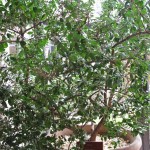Friday, October 28, 2011
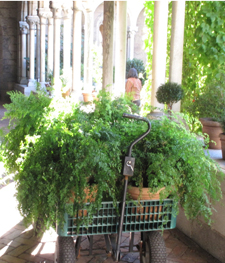
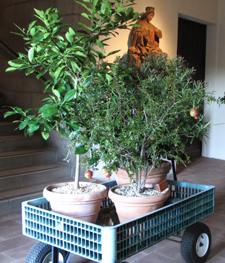
Potted plants too tender to spend the winter in Bonnefont garden are trucked inside and brought up to Cuxa cloister, which is??glazed in mid-October. Mediterranean plants such as bitter orange, myrtle, and bay laurel spend the cold season in the sunny arcades and??are brought back out to the herb garden when the glass comes down in mid-April. Left:??A wagonload of maidenhair fern in the arcade of Bonnefont garden. Right:??oranges and pomegranates en route to Cuxa cloister.?? Photographs by Carly Still
While the medieval plant collection at The Cloisters includes a good number of northern European species, a great many of the plants grown in the Bonnefont Cloister herb garden are Mediterranean in origin. Not all of these southern European plants are hardy for us here in New York City. The garden is a sheltered U.S.D.A. Hardiness Zone 7, and the fig tree (Ficus carica), poet’s jasmine (Jasminum officinale), and lavender (Lavandula angustifolia) do just fine outdoors, but more tender species like bitter orange (Citrus aurantium), rosemary (Rosmarinus officinalis), bay laurel (Laurus nobilis), and dittany of Crete (Origanum dictamnus) must be brought inside and protected from the cold. Read more »
Tags: Albertus Magnus, bay, Citrus aurantium, cucumber, cucurbit, dittany, fern, ficus carica, fig, jasmine, Jasminum officinale, laurel, Laurus nobilis, Lavandula angustifolia, Lavender, maidenhair, myrtle, orange, Origanum dictamnus, rosemary, Rosmarinus officinalis, santolina, winter
Posted in Food and Beverage Plants, Fragrant Plants, Gardening at The Cloisters, Introduction, Magical Plants, Medicinal Plants, Medieval Agriculture, Plants in Medieval Art | Comments (2)
Monday, February 1, 2010
Above, from left to right: common myrtle is grown in pots at The Cloisters and brought indoors before frost; detail of the ivory-white blossoms of Myrtus communis; detail of the blue-black fruits of the common myrtle.
In myrtle shades oft sings the happy swain,
In myrtle shades despairing ghost complain.
The myrtle crowns the happy lovers??? heads,
Th??? unhappy lovers’ graves the myrtle spreads.
???Verses Written at The Request of a Gentleman to whom a Lady had Given a Sprig of Myrtle, by Samuel Johnson
This eighteenth-century verse is a deft summation of many centuries of the myrtle???s association with love, lovers, and the goddess of love. Read more »
Tags: Esther, herb, Hippolytus, love, myrtle, myrtus communis, Ovid, Pausanias, perfume, Phaedra, Pliny, Samuel Johnson, unguent
Posted in Food and Beverage Plants, Fragrant Plants, Gardening at The Cloisters | Comments (2)
Friday, January 23, 2009
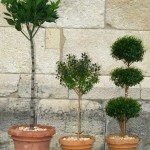
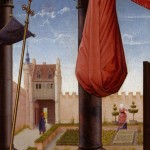
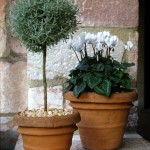
Above, from left to right: Topiaries in the plant collection at The Cloisters; detail from The Annunciation, 1465???75, Workshop of Rogier van der Weyden (possibly Hans Memling, active by 1465, died 1494) (Netherlandish, 1399/1400???1464), The Metropolitan Museum of Art, New York, Gift of J. Pierpont Morgan, 1917 (17.190.7); cotton lavender topiary in Cuxa Cloister.
Medieval topiary was relatively simple and non-representational. Woody plants were trained to standards topped by balls, or to a characteristically medieval form known as an estrade, in which the plant was grown in tiers. Although these are rarely represented before 1400, many fifteenth-century artworks show estrades and other simple, geometric forms growing both in pots and in garden beds. The more ornate representational topiary known to the Romans was revived in Renaissance Italy; the Rucellai garden in Florence, created in the second half of the fifteenth century, included animals and human figures, as well as topiary temples and urns.
The practice of artfully clipping and training woody plants into formal or fanciful shapes can be traced back to imperial Rome and the Natural History of Pliny the Elder, who attributes the relatively recent invention of nemora tonsilia or “barbered groves” to one Gaius Matius, a Roman knight and a friend of the Emperor Augustus (John Boardman, The Oxford History of the Roman World, 2001). Read more »
Tags: bay, cotton lavender, estrade, herb, Laurus nobilis, Myrtis communis, myrtle, rosemary, Rosmarinus officinalis, Santolina chamaecyparissus, topiary
Posted in Fragrant Plants, Gardening at The Cloisters | Comments (6)



